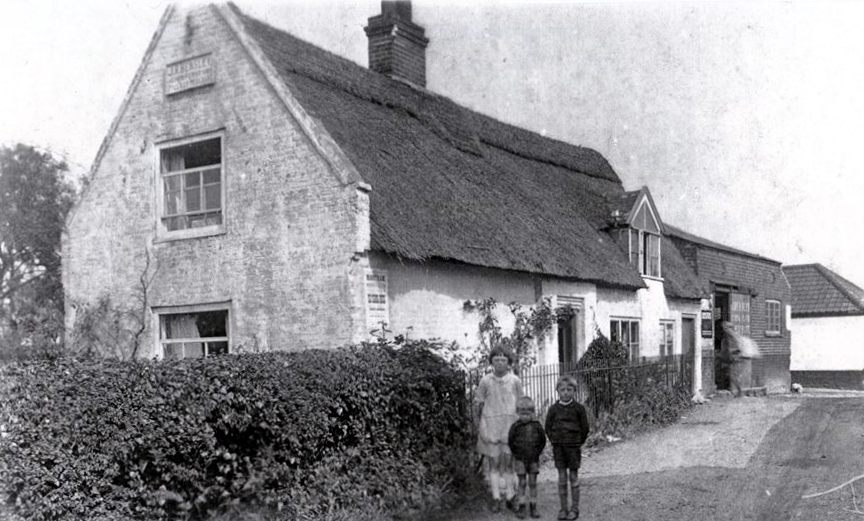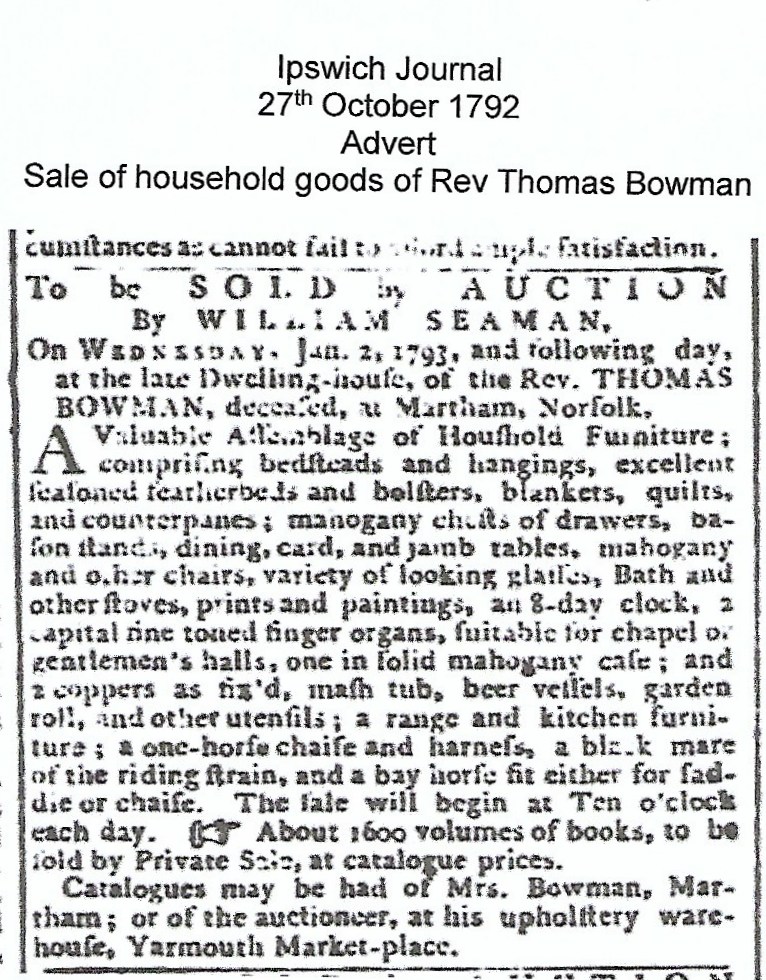Rev. Thomas Bowman (1728-1792). Vicar of St Mary the Virgin, Martham

Thomas Bowman was the vicar of St Mary the Virgin from 1759 until his death in 1792. He was born in London in 1728 and his parents were John Bowman, a printer, and Elizabeth, nee Clark. He was baptised on 23rd January 1728 at St Giles, Cripplegate. He was married to Sarah Goodall at Cambridge, date unknown but probably around 1753.
He was educated at Christ’s Hospital School, Horsham, West Sussex where he matriculated as a Greek scholar in 1747. He gained his B.A. in 1750 at Pembroke College, Cambridge and was ordained a Deacon at Cambridge on 2nd June 1751. He was appointed as a Priest and Curate without specification of parish or salary on 24th May 1752. He achieved his M.A. in 1753 and was elected a Fellow of Trinity Collage Cambridge in September 1785.
He was appointed by the Dean & Chapter of Norwich Cathedral as the Vicar of Martham where he worked from 17th January 1759 until his death in 1792.
He was listed in the Martham Electoral Register of 1768 as a Clergyman and in 1784 taught nine children at the Free School, (shown right) near The Green in the village.

Thomas belongs to a small group of 18th century Anglican clergymen who were also active as composers. His education at the charity school of Christ’s Hospital in London and Pembroke Hall in Cambridge awakened a keen interest in music. While still a student, Thomas had two collections of songs and cantatas published, the second of which gained 181 subscribers. Whether from religious conviction or because his works proved insufficiently successful with the public, Thomas took holy orders and became first a curate at Holbeach, Lincolnshire, before being appointed as the Vicar at Martham. At Holbeach he produced a set of trio sonatas and at Martham a final collection of songs. During the 1760s Thomas was drawn into Evangelical Anglicanism, becoming a passionate and influential propagandist for the Calvinian doctrine of predestination, which he propounded in several books and pamphlets. His musical activity declined steeply, although in 1774-5 and 1780-81 he produced several hymns.
Thomas’ musical talent has been claimed by his peers to be “slender, not rising above a certain gift for melody. His early works, in particular the longer and more ambitious ones, betray a lack of instruction. However, his career tells us a lot about the state of English secular music in the middle of the 18th century and the participation of the clergy within it.”
In 1766 he established a congregation at Cawston, Norfolk and ministered to its members continuously for about a quarter of a century apparently feeling that they needed to be rescued from what he regarded as their deplorable state, although his own parish was only about twenty miles away at Martham. On his retirement in 1791 he published a book, which is not an easy read, called Caustoniana, or Twelve Discourses, addressed to the inhabitants of the parish of Cawston. He died on 15th June 1792, a year after the publication of his book.

His funeral oration was delivered by his former curate Rev. Stephen Webster at his burial in Martham on 19th June 1792 saying:-
“Music in his younger days was his darling study, he was almost an enthusiastic amateur of the science; formerly he published several things and the great Handel used to tell him, ‘he would soon be his master’; he had thoughts of taking his degree in music, but it was providentially over-ruled. He was designed for greater usefulness and called to infinitely more important services in the church of Christ”.
In his funeral sermon at Martham for Rev. Bowman on 19th June 1792 Stephen Webster vicar of Claxton said: He left a paper containing the following words: “I desire to be buried in the Chancel, on the “north side of Mr. Savage, and to have a stone “of the same size and colour as his, and that the “following particulars may be engraved on it: “Here is deposited the mortal part of Thomas Bowman, M. A. vicar of this parish, he died (June 15, 1792, aged 64), in hope of a blessed resurrection to eternal life, thro’ our Lord Jesus Christ.”
Thomas was buried in the Chancel of St Mary the Virgin, Martham on the north side of the grave of his predecessor Rev. James Savage.

We can get an idea of how a vicar lived in the late 18th century from the sale of Thomas Bowman’s goods and chattels after he died. They were sold in two phases: after he died his wife, Sarah, would have been obliged to leave the Martham Vicarage so that the new incumbent could live there. So she decided to sell her husband’s belongings. A sale took place at the Vicarage on 7th August 1792 and succeeding days. This included his collection of books, music and coins, plus a spinet. Later on remaining property, some suited to chapel use, was auctioned by William Seaman of Great Yarmouth on 2nd January 1793 after being advertised in The Ipswich Journal several times. One of the adverts is shown below and listed his household goods which included two organs and a two-wheeled, one-horse carriage called a chaise plus two horses.

Sources:
Appointment information courtesy of the: Clergy of the Church of England Database at https://theclergydatabase.org.uk
“Glimpses into the History of the Village of Martham” by Ann Meakin.
Information from Peter Lavender.